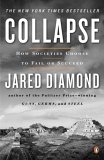Summary | Excerpt | Reading Guide | Reviews | Beyond the Book | Readalikes | Genres & Themes | Author Bio

Critics' Opinion:
Readers' Opinion:
First Published:
Dec 2004, 575 pages
Paperback:
Jan 2006, 592 pages
 Book Reviewed by:
Book Reviewed by:
BookBrowse Review Team
Buy This Book
In addition, I don't know of any case in which a society's collapse can
be attributed solely to environmental damage: there are always other
contributing factors. When I began to plan this book, I didn't appreciate
those complications, and I naïvely thought that the book would just be about
environmental damage. Eventually, I arrived at a five-point framework of
possible contributing factors that I now consider in trying to understand any
putative environmental collapse. Four of those sets of factors—environmental
damage, climate change, hostile neighbors, and friendly trade partners—may or
may not prove significant for a particular society. The fifth set of
factors—the society's responses to its environmental problems—always
proves significant. Let's consider these five sets of factors one by one, in a
sequence not implying any primacy of cause but just convenience of presentation.
A first set of factors involves damage that people inadvertently inflict on
their environment, as already discussed. The extent and reversibility of that
damage depend partly on properties of people (e.g., how many trees they cut down
per acre per year), and partly on properties of the environment (e.g.,
properties determining how many seedlings germinate per acre, and how rapidly
saplings grow, per year). Those environmental properties are referred to either
as fragility (susceptibility to damage) or as resilience (potential for recovery
from damage), and one can talk separately of the fragility or resilience of an
area's forests, its soils, its fish populations, and so on. Hence the reasons
why only certain societies suffered environmental collapses might in principle
involve either exceptional imprudence of their people, exceptional fragility of
some aspects of their environment, or both.
A next consideration in my five-point framework is climate change, a term
that today we tend to associate with global warming caused by humans. In fact,
climate may become hotter or colder, wetter or drier, or more or less variable
between months or between years, because of changes in natural forces that drive
climate and that have nothing to do with humans. Examples of such forces include
changes in the heat put out by the sun, volcanic eruptions that inject dust into
the atmosphere, changes in the orientation of the Earth's axis with respect to
its orbit, and changes in the distribution of land and ocean over the face of
the Earth. Frequently discussed cases of natural climate change include the
advance and retreat of continental ice sheets during the Ice Ages beginning over
two million years ago, the so-called Little Ice Age from about a.d. 1400 to
1800, and the global cooling following the enormous volcanic eruption of
Indonesia's Mt. Tambora on April 5, 1815. That eruption injected so much dust
into the upper atmosphere that the amount of sunlight reaching the ground
decreased until the dust settled out, causing widespread famines even in North
America and Europe due to cold temperatures and reduced crop yields in the
summer of 1816 ("the year without a summer").
Climate change was even more of a problem for past societies with short human
lifespans and without writing than it is today, because climate in many parts of
the world tends to vary not just from year to year but also on a multi-decade
time scale; e.g., several wet decades followed by a dry half-century. In many
prehistoric societies the mean human generation time—average number of years
between births of parents and of their children—was only a few decades. Hence
towards the end of a string of wet decades, most people alive could have had no
firsthand memory of the previous period of dry climate. Even today, there is a
human tendency to increase production and population during good decades,
forgetting (or, in the past, never realizing) that such decades were unlikely to
last. When the good decades then do end, the society finds itself with more
population than can be supported, or with ingrained habits unsuitable to the new
climate conditions. (Just think today of the dry U.S. West and its urban or
rural policies of profligate water use, often drawn up in wet decades on the
tacit assumption that they were typical.) Compounding these problems of climate
change, many past societies didn't have "disaster relief" mechanisms to
import food surpluses from other areas with a different climate into areas
developing food shortages. All of those considerations exposed past societies to
increased risk from climate change.
From Collapse by Jared Diamond. Copyright Jared Diamond 2005. All rights reserved. No part of this book maybe reproduced without written permission from the publisher.





The Funeral Cryer by Wenyan Lu
Debut novelist Wenyan Lu brings us this witty yet profound story about one woman's midlife reawakening in contemporary rural China.
Your guide toexceptional books
BookBrowse seeks out and recommends the best in contemporary fiction and nonfiction—books that not only engage and entertain but also deepen our understanding of ourselves and the world around us.